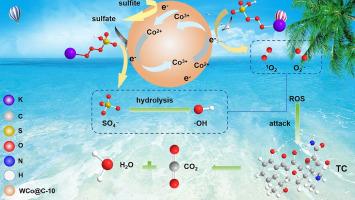Melamine modified POM@MOF composites (WCo@C) for enhanced activation of peroxymonosulfate to efficiently degrade tetracycline
IF 5.4
3区 化学
Q1 CHEMISTRY, INORGANIC & NUCLEAR
引用次数: 0
Abstract
Tetracycline (TC) antibiotics in aquatic environments pose severe ecological and health risks due to their difficult biodegradability and environmental accumulation. Persulfate-based advanced oxidation process (PS-AOP) has been proven to be a promising method for TC degradation in wastewater treatment but requires efficient, stable catalysts. Herein, three melamine-modified POM@MOF composites WCo@C-1, WCo@C-5 and WCo@C-10 (WCo-PMOFs and melamine in mass ratios of 1:1, 1:5, and1:10, respectively) were synthesized by calcining a mixture of WCo-PMOFs and melamine, which were used as catalysts for peroxymonosulfate (PMS) activation to degrade TC efficiently. The results demonstrated that the TC degradation rate by WCo @ C-10 activated persulfate (PMS) reached 95.83 % within 2 h superior to that of WCo@C-1 and WCo@C-5 under the same experimental conditions. Notably, the WCo@C-10/PMS system exhibited exceptional cycling stability, maintaining a degradation efficiency of 83.51 % even after four consecutive cycles. The X-ray photoelectron spectroscopy (XPS) and electrochemical impedance spectroscopy (EIS) characterization results indicate that the WCo@C-10 composite material exhibits outstanding catalytic performance. This characteristic is mainly attributed to the significant improvement in the material's dispersion and its having the smallest impedance arc radius among a series of materials, which reflects a lower charge transfer resistance and excellent electrical conductivity. These characteristics synergistically promote the efficient conversion of Co(III) to Co(II). The quenching experiment combined with electron paramagnetic resonance (EPR) analysis confirmed that superoxide radicals (O2·-) and singlet oxygen (1O₂) are the main reactive oxygen species in this system. This study provides a new idea for designing efficient PMS-based advanced oxidation systems.

三聚氰胺改性POM@MOF复合材料(WCo@C),增强过氧单硫酸盐的活化,有效地降解四环素
四环素类抗生素由于其难以生物降解和环境积累,在水生环境中存在严重的生态和健康风险。过硫酸盐基深度氧化法(PS-AOP)已被证明是一种很有前途的废水处理中降解TC的方法,但需要高效、稳定的催化剂。本文通过煅烧WCo-PMOFs和三聚氰胺的混合物,合成了三聚氰胺改性POM@MOF复合材料WCo@C-1、WCo@C-5和WCo@C-10 (WCo-PMOFs和三聚氰胺的质量比分别为1:1、1:5和1:10),并将其用作过氧单硫酸盐(PMS)活化催化剂,以高效降解TC。结果表明,在相同的实验条件下,WCo@ C-10活化过硫酸盐(PMS)在2 h内对TC的降解率达到95.83%,优于WCo@C-1和WCo@C-5。值得注意的是,WCo@C-10/PMS体系表现出优异的循环稳定性,即使在连续4次循环后仍保持83.51%的降解效率。x射线光电子能谱(XPS)和电化学阻抗谱(EIS)表征结果表明WCo@C-10复合材料具有优异的催化性能。这主要是由于该材料的色散得到了显著改善,并且在一系列材料中具有最小的阻抗弧半径,这反映了较低的电荷转移电阻和优异的导电性。这些特性协同促进了Co(III)向Co(II)的有效转化。猝灭实验结合电子顺磁共振(EPR)分析证实,超氧自由基(O2·-)和单重态氧(o₂)是该体系中主要的活性氧。本研究为设计高效的基于pms的高级氧化系统提供了新的思路。
本文章由计算机程序翻译,如有差异,请以英文原文为准。
求助全文
约1分钟内获得全文
求助全文
来源期刊

Inorganic Chemistry Communications
化学-无机化学与核化学
CiteScore
5.50
自引率
7.90%
发文量
1013
审稿时长
53 days
期刊介绍:
Launched in January 1998, Inorganic Chemistry Communications is an international journal dedicated to the rapid publication of short communications in the major areas of inorganic, organometallic and supramolecular chemistry. Topics include synthetic and reaction chemistry, kinetics and mechanisms of reactions, bioinorganic chemistry, photochemistry and the use of metal and organometallic compounds in stoichiometric and catalytic synthesis or organic compounds.
 求助内容:
求助内容: 应助结果提醒方式:
应助结果提醒方式:


